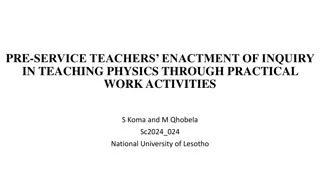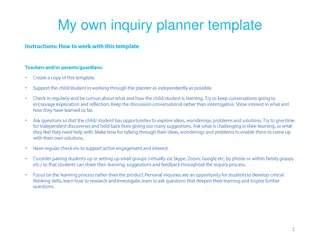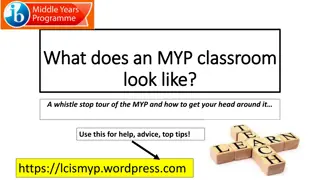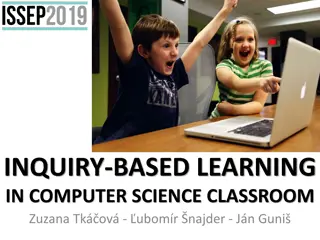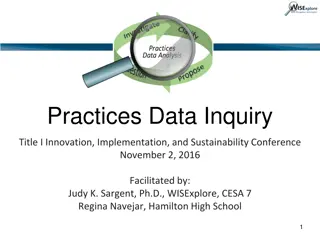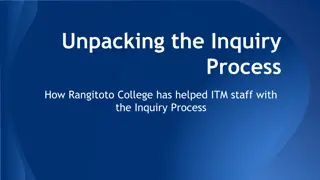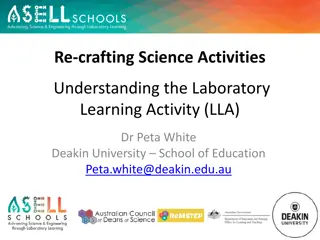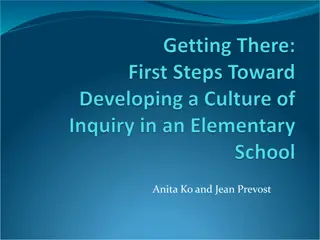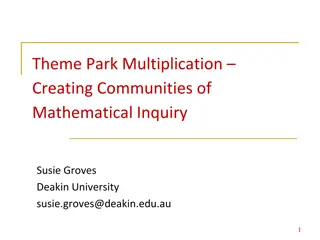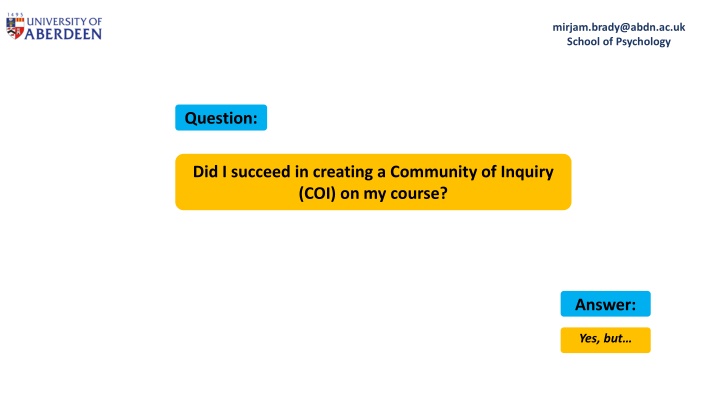
Creating a Community of Inquiry in Higher Education
Discover how to succeed in establishing a Community of Inquiry (COI) on a course, utilizing the Social Presence, Cognitive Presence, and Teaching Presence framework. Learn about the essential elements and functions required for a successful educational experience, including fostering personal connections, engaging in meaningful discourse, and facilitating learning outcomes.
Download Presentation

Please find below an Image/Link to download the presentation.
The content on the website is provided AS IS for your information and personal use only. It may not be sold, licensed, or shared on other websites without obtaining consent from the author. If you encounter any issues during the download, it is possible that the publisher has removed the file from their server.
You are allowed to download the files provided on this website for personal or commercial use, subject to the condition that they are used lawfully. All files are the property of their respective owners.
The content on the website is provided AS IS for your information and personal use only. It may not be sold, licensed, or shared on other websites without obtaining consent from the author.
E N D
Presentation Transcript
mirjam.brady@abdn.ac.uk School of Psychology Question: Did I succeed in creating a Community of Inquiry (COI) on my course? Answer: Yes, but
Community of Inquiry as guiding framework a conceptual framework that identifies the elements that are crucial prerequisites for a successful higher educational experience (Garrison, Anderson & Archer, 2000) There need to be 3 presences for a successful course: Cognitive Actively wrestling with material, dialogue Social Being their real self in the community Teaching What educators do to facilitate Soc and Cog
Social Presence The extent to which participants (staff and students) in the community can project their personal characteristics into the community, presenting themselves as real people. There are 3 dimensions of Social Presence, based on students needs as they move through the course: a.Developing their identity as a Psychology student b.Communicating purposefully in a trusting environment c. Building interpersonal relationships (friendships) Functions: 1.Support Cognitive Presence (discussions work better if people can be real with one another and when there is trust) 2.Prevent drop-out (students need to find the interactions in the group rewarding and personally fulfilling)
Cognitive Presence The extent to which students can construct and confirm meaning through sustained discourse (with each other and with staff). There are 4 phases, which have most chance of being worked through by students in this order if the teaching framework is designed with logical flow: 1.Triggering event (learners recognize there is a problem and have a sense of puzzlement) 2.Exploration (learners use different sources and discuss with one another to understand things better) 3.Integration (learners reflect on information gathered, link ideas and try to come up with solutions) 4.Resolution (learners apply knowledge created to new situations; test solutions or defend them)
Teaching Presence The extent to which social and cognitive presence are supported through: Design of the educational experience (selecting, organizing, presenting course content, learning activities and assessments) Facilitation (setting a climate for learning, encouraging discussion, drawing everyone in) with the ultimate aim to realize learning outcomes.
Cognitive Presence Social Presence Checklist: describe what either staff or students (or both) are doing to meet each criterion Checklist: describe what either staff or students (or both) are doing to meet each criterion Staff Students Staff Students Participants feel secure to express themselves freely (open communication) A problem is presented Participants explore together Participants trust one another (interpersonal interaction) Participants engage with teaching content There is a sense of group identity (cohesion) Students use what they have learned to come up with solution Students can successfully collaborate (cohesion) Students apply what they have learned to new situation Participants feel free to express emotions Students know who staff are Teaching Presence Other Checklist: describe what either staff or students (or both) are doing to meet each criterion Checklist: describe what either staff or students (or both) are doing to meet each criterion Staff Students Staff Students There is a logical flow of course materials (topics, difficulty) Navigation on the course page is logical There is a logical flow of assignments (formative, summative, building on one another) There is immediacy Learning is encouraged Discussion is encouraged Everyone is encouraged to contribute
Cognitive Presence Social Presence Checklist: describe what either staff or students (or both) are doing to meet each criterion Checklist: describe what either staff or students (or both) are doing to meet each criterion Staff Students Staff Students A problem is presented Setting assignment with rationale for how they fit into the broader learning outcomes (see picture next slide) Participants feel secure to express themselves freely (open communication) Setting ground rules Lecture videos with face Welcome video with face Participants explore together Setting weekly compulsory tasks on forum, related to assignment Students post 1 and comment on 2 Participants trust one another (interpersonal interaction) Setting ground rules Collaborating on set tasks Responding to comments on forum Giving peer feedback Participants engage with teaching content Setting MCQs about lectures (these already were open book so much harder than closed book questions) Break up the lecture recordings into 15 min chunks to help maintain concentration. Students comment on 2 posts There is a sense of group identity (cohesion) Put students into groups of no more than 40, with funky Psychology name Have a separate communication board for each Have an icebreaker per group Students use what they have learned to come up with solution Setting of assignments (applies to all) Students comment on 2 posts Students help one another PAL-style Students can successfully collaborate (cohesion) Setting ground rules Participants feel free to express emotions Create a student-only breakout room in BB collaborate Allow emoticons on forum and email. Students apply what they have learned to new situation Setting of presentation assignment -> Students collaborate in small groups to create presentation (with written notes) about related material. If we had enough tutors (even just on the day) we could break class into smaller groups and present through BB collaborate (I ve done this, it works). Students know who staff are Lecture videos with face Active presence several times a week (on fora, announcement, weekly BB collaborate live session weekly chat with Mirjam ) Teaching Presence Other Checklist: describe what either staff or students (or both) are doing to meet each criterion Checklist: describe what either staff or students (or both) are doing to meet each criterion Staff Students Staff Students There is a logical flow of course materials (topics, difficulty) PS1011 was already designed this way (see picture on next slide) Navigation on the course page is logical At the top a Welcome folder. A How the course works document in Course Information, with a timelined flowchart. Consistent labelling of files and folders. Clear labelling of files and folders. Make folders selectively available. There is a logical flow of assignments (formative, summative, building on one another) PS1011 was already designed this way Learning is encouraged Giving feedback that focuses on how far they ve come. Don t give answers, but ask more questions so students have to find out more themselves. Peer feedback to drafts. Help peers in a PAL-like setting (within the course) Discussion is encouraged Contribution to discussion forum is compulsory (post 1, respond to 2, and respond to all who comment on your post) and graded (in basic bands to reflect level of engagement). Tutors moderate the fora and ask Socratic questions. Post 2 comments to other people s posts, which these other people will have to interact with There is immediacy Respond to student emails within 48 hours. Check fora every day Give feedback on assignments within 2 weeks. Respond to others within 48 hours Everyone is encouraged to contribute Contribution is compulsory (see above). Setting ground rules re: behaviour (e.g., not dominate for a), that can be enforced.
Aim: developing research skills What my course looks like Writing Being able to communicate your ideas in a clear way Presenting Being able to evaluate scientific articles Writing critical Review Being able to summarize scientific articles Writing annotated bibliography Being able to find and understand scientific articles (scientific language, methodology) Answering scientific article questions Taking part in experiments Attending lectures
The study 32 participants from this course Questionnaire with open + rating scale questions Distributed online halfway through the 2nd semester
Cognitive: Did talking and discussing with others (staff and students) on PS1511 contribute to your learning? Please explain how this worked, or explain why it didn t help. Social: Do you feel you could be your real self as a student on the PS1511 course? If so, what do you think caused that? If not, what do you think prevented it? Teaching: What is the general learning atmosphere like on the course PS1511? Did the course structure (i.e., assessments, week-to-week tasks) support or hinder your learning? Please explain. Cognitive Social Teaching Atmosphere arises out of course design it feels like I am allowed to talk and put my points across if I need or want to and it feels like that is due to the encouraging and supporting way the course is structured by the staff. Peers are for reassurance It made me feel like I am not alone, that others have the same concerns and issues that I have, that we're all in the same boat and improve our learning together. Staff are for motivation and deeper learning you can only learn so much from other students Being yourself depends on knowing others I got to know some people in smaller discussions and group projects already, and when I meet them I feel encouraged to tell them about myself Live chat with lecturer is authentic encounter I feel encouraged to be myself by members of staff who present themselves as truly being open and honest and their genuine self It's a rather relaxed atmosphere to the point you are getting the work done and not fully realising it
17 rating-scale questions Analyzed with one-sample t-tests (is it different from midpoint of scale)
Cognitive Presence Social Presence Checklist: describe what either staff or students (or both) are doing to meet each criterion Checklist: describe what either staff or students (or both) are doing to meet each criterion Staff Students Staff Students Participants feel secure to express themselves freely (open communication) A problem is presented Participants explore together Participants trust one another (interpersonal interaction) Participants engage with teaching content There is a sense of group identity (cohesion) Students use what they have learned to come up with solution Students can successfully collaborate (cohesion) Students apply what they have learned to new situation Participants feel free to express emotions Students know who staff are Teaching Presence Other Checklist: describe what either staff or students (or both) are doing to meet each criterion Checklist: describe what either staff or students (or both) are doing to meet each criterion Staff Students Staff Students There is a logical flow of course materials (topics, difficulty) Navigation on the course page is logical There is a logical flow of assignments (formative, summative, building on one another) There is immediacy Learning is encouraged Discussion is encouraged Everyone is encouraged to contribute
17 rating-scale questions (1 = not at all, 7 = completely) Analyzed with one-sample t-tests (is it different from midpoint of scale?) Largest* effects (means) for: Teaching Logical flow of assignments (6.3) Cognitive Have to use what I learnt (6.0) Teaching Logical flow of materials (6.0) Social I know who teaching staff are (5.9) Cognitive Content engages me (5.8) Cognitive Assignments encourage learning (5.9) Teaching Feel encouraged in my learning (5.8) Social Feel secure to express self with staff (5.5) Not significantly different (p-value) from midpoint of scale Social There is a sense of group identity (.489) Social I feel free to express emotions (.601) Cognitive I feel I m exploring with other students (.385) *Other items were significant too, but too close to the neutral midpoint to be meaningful, e.g.: Social: I can successfully collaborate with others (mean = 4.8, sd = 1.8)
Question: Did I succeed in creating a Community of Inquiry (COI) on my course? Teaching presence is easiest to achieve, social presence the hardest Greatest learning when staff become peers in an authentic encounter Yes, but Answer:
How can we enhance student social presence? Social presence is NOT discussing in groups it s the precursor to that How can we build their social identity (as Psy students)? How can we help develop mutual trust? How can we help build interpersonal relationships? The course is here



